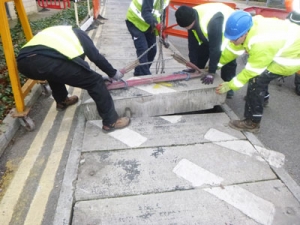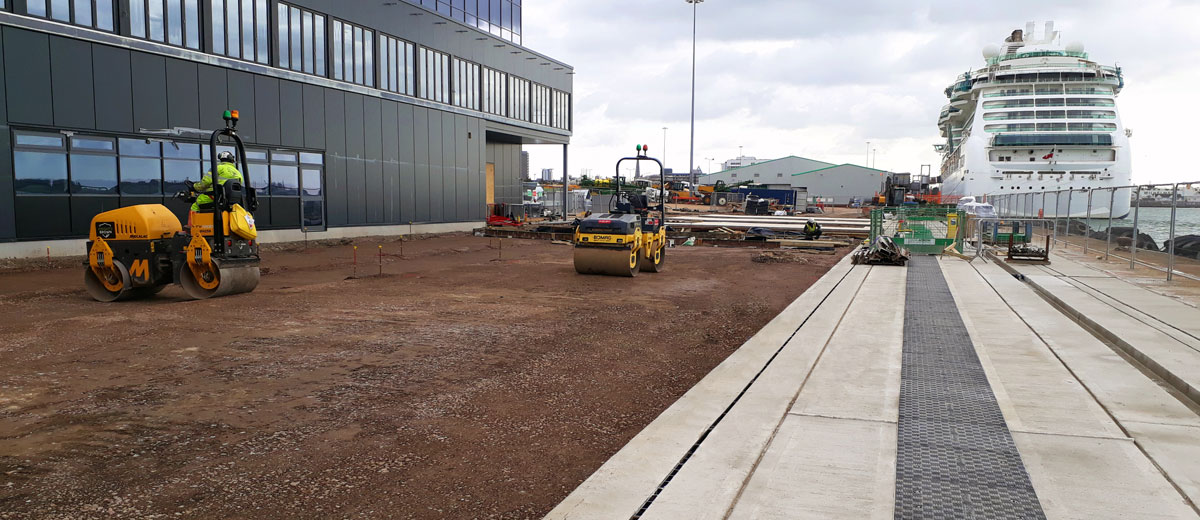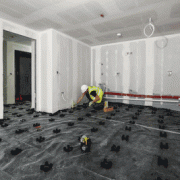Custom Fibrelite covers installed in precast concrete manufacturer Trenwa’s troughs at major US sub-station AND
Fibrelite trough covers are designed to be safely and easily removed by two people
Composite access cover manufacturer Fibrelite has formed strategic partnerships with a number of major manufacturers of precast and preformed troughs (also known as trenches, channels and ducts) in Europe and the USA (including Fibex and Trenwa) to create new collaborative product offerings integrating Fibrelite covers and precast and preformed troughs, combining the strength and longevity of precast and preformed troughs with the easy, safe manual removal and durability of Fibrelite’s lightweight composite covers.

Concrete slab covers can weigh as much as five times the weight of an equivalent size Fibrelite GRP composite trough cover
Health and safety issues surrounding manual handling are of paramount importance to site managers. Without the necessary provision of dedicated lifting apparatus and training for operatives, traditional concrete and steel trough access covers can be a concern due to their sheer weight. Concrete slab covers can weigh as much as five times the weight of an equivalent size Fibrelite GRP composite trough cover.

Custom Fibrelite covers designed & engineered to fit precast manufacturer Fibex’s preformed GRP troughs
Fibrelite covers have an industry leading strength-to-weight ratio and are designed to be safely and easily removed by two people, using the Fibrelite FL7 ergonomically designed lifting handles.
Driven by focusses on health and safety, weight, durability (no corrosion) and reduced installation time, GRP composite access covers have moved from being a niche product used on petrol station forecourts to being specified at the outset of new build and retrofit projects for some of the world’s most prestigious brands in technology, data centres, ports, airports, high-tech manufacturing facilities, utilities, infrastructure and many more.
“In recent years, the demand for highly customisable, high-tech access covering solutions has grown exponentially, and we’re proud of the part we’ve played in their adoption over the 40 years since we invented the world’s first. Since then, we’ve continually innovated, focussing on creating solutions to industry and customer challenges.” Commented Ian Thompson, Fibrelite’s Managing Director EMEA “Partnering with precast and preformed trough/trench manufacturers was a logical next step, and I’m proud to say that, since we created our first partnership offering with Trenwa in 2014 we now have over 50 kilometres of our covers installed in precast and preformed troughs across the globe”
David Holmes, Fibrelite’s Technical Director added “We work closely with architects, contractors, and end users from tender stage right the way through to delivery and even installation where required. This collaborative process ensures that the supplied product fulfils both product quality demands and strict project completion deadlines. Fibrelite covers can be custom designed and manufactured with dimensions matched precisely to specified trough opening/rebate dimensions (Fibrelite’s adjustable tooling allows covers to be manufactured within millimetres of a clients requirement)”
Recent Installation: New Build Data Centre, Northern Europe (shown above)
Some clients favour a complete GRP solution for both troughs and covers. Where appropriate, this can further reduce installation costs and time due to their reduced weight for transit and installation. Earlier this year, Fibrelite engineered and manufactured 550 metres of custom trough covers for a new build data centre in Northern Europe. These GRP preformed troughs were supplied with custom fit Fibrelite bolt-down covers, for added security.
Recent Installation: Cruise Ship Terminal, UK
Fibrelite custom engineered and manufactured 500 metres of F900 (90-tonne) load rated GRP trough covers to fit precast concrete troughs at a UK cruise ship terminal. The stepped covers were supplied in a number of customised sizes to fit the trough configuration. The F900 load rated covers were stepped to reduce the unit weight in compliance with the customer’s specified manual handling limit.
For more information, click here to visit the Fibrelite website

F900 (90-tonne) load rated GRP Fibrelite trench covers in precast concrete troughs/trenches at a cruise ship terminal


 Mul-T-Lock’s Hasplock DIAMOND is a robust and burglar-resistant locking solution that allows for the padlock and hasp to be incorporated into one stainless steel unit, with a locking bolt that cannot be removed.
Mul-T-Lock’s Hasplock DIAMOND is a robust and burglar-resistant locking solution that allows for the padlock and hasp to be incorporated into one stainless steel unit, with a locking bolt that cannot be removed. These new additions to the eCLIQ® range are now providing users with access control and audit trail capabilities for even the most remote locations. From shipping containers, perimeter fencing and gates, to fleet management companies, theme parks and outdoor sports centres across the UK.
These new additions to the eCLIQ® range are now providing users with access control and audit trail capabilities for even the most remote locations. From shipping containers, perimeter fencing and gates, to fleet management companies, theme parks and outdoor sports centres across the UK.


 The project build plan was redesigned around the installation of the Instacoustic cradle and batten system with the UFCM designed Underfloor heating system. This provided construction time benefits to be gained. This also included the time-saving, auto-balancing manifold. Using patented valve technology, UFCM’s Stainless Steel Auto-Balancing Manifold constantly adjusts each circuit to the desired flow rate, ensuring the underfloor heating system operates with optimum temperature distribution and maximum energy efficiency. The use of the cradle and batten system allows for the work programme to be condensed – which would not have been possible to achieve with a screed system or the specified rigid board system at the Potato Wharf site.
The project build plan was redesigned around the installation of the Instacoustic cradle and batten system with the UFCM designed Underfloor heating system. This provided construction time benefits to be gained. This also included the time-saving, auto-balancing manifold. Using patented valve technology, UFCM’s Stainless Steel Auto-Balancing Manifold constantly adjusts each circuit to the desired flow rate, ensuring the underfloor heating system operates with optimum temperature distribution and maximum energy efficiency. The use of the cradle and batten system allows for the work programme to be condensed – which would not have been possible to achieve with a screed system or the specified rigid board system at the Potato Wharf site.
